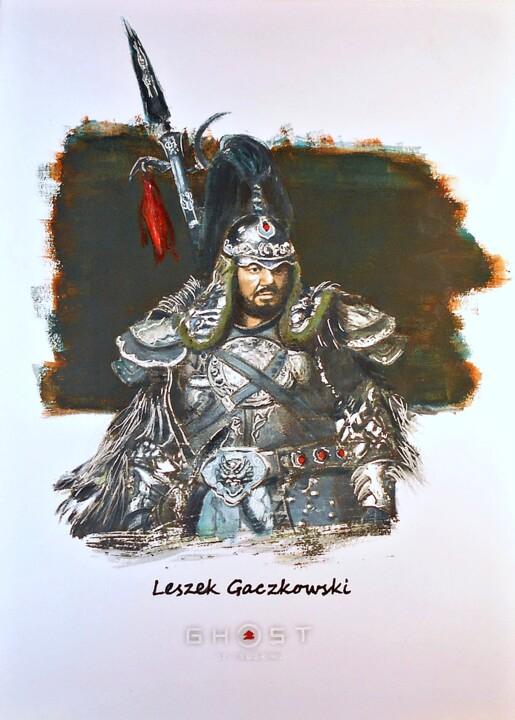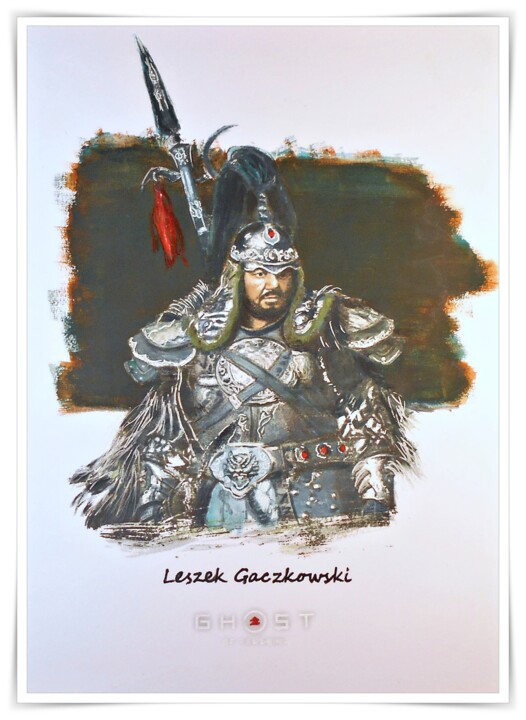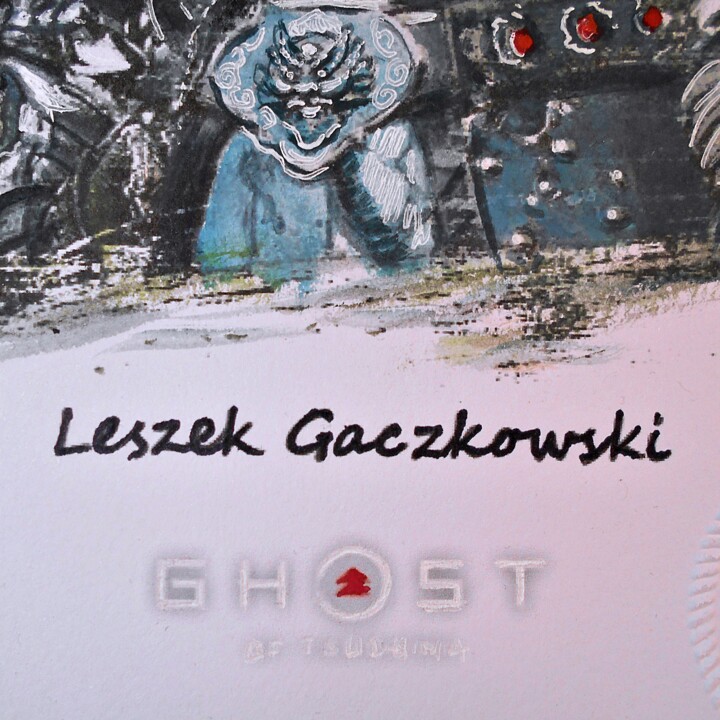





让我们知道您是否想看到这件艺术品的更多照片!
- 工作的背面 / 工作的一面
- 细节 / 签名 / 艺术品的表面或纹理
- 情境中的艺术品, 其他...
GHOST OF TSUSHIMA 002 / 23 - CHARACTERS - Khan - (2023) (2023) 绘画 由 Leszek Gaczkowski
更多信息
- 包装 (盒子或纸箱包装) 所有的作品都配有优质的承运方,经过严格的包装保护和已投保。
- 监控 跟踪订单,直到包裹交付给买方. 将提供跟踪号码,以便您可以实时跟踪包裹。
- 延迟 大多数包裹在1至3周内在全球范围内交付 (估计)
- 不包括海关 价格不包括海关费用。大多数国家/地区对原创艺术品没有进口税,但您可能需要支付减免的增值税。海关费用(如果有)将由海关在抵达时计算,并由承运人单独计费。
更多信息
- 可追踪的在线真品证书 可以通过扫描插图的代码随时在线验证真品证书。
- 认证评级艺术家 专家研究一个艺术家的工作和职业生涯,然后建立一个独立的,可靠的平均价格值。平均价格价值座落在一个价格范围内的某一时期的艺术家。专家们也可能被要求建立一个更精确的估计为特定的工作。
更多信息
使用SSL证书进行100%安全付款 + 3D Secure.
更多信息
“艺术”在纸上打印
这是使用非常高质量的颜料墨水在美术纸上打印并以很高的清晰度打印的过程。它的保存水平非常出色(超过100年),其质量,深度和细微差别超过了在Argentic纸上的经典照片打印。

光面漆
纤维纸除了具有非凡的厚度外,还由不含酸的α-纤维素基底组成,并覆盖有硫酸钡和在印刷过程中具有微孔层吸收作用的颜料。这款纸色为纯白色,不泛黄,特别设计用于抵抗老化。它具有出色的分辨率,呈现深沉的色彩,因此已被世界各大博物馆所采用。
Art Print“美术”-在325 g纤维原纸上的光泽处理。

我们的高端印刷品和复制品
ArtMajeur仅使用从知名造纸商中精选的具有中性pH,耐性和高质量的天然纸!
无论是在色彩控制还是在图形链方面,我们的主打印机一直都在关注。我们对质量的高要求是ArtMajeur裱框艺术品的主要资产。
关于艺术家! 您可以帮助艺术家活出自己的生活。 每当您购买印刷品时,他们都会获得使用费。
关于我们的优良打印购买许可证以将此图像用于您的网站、通信或销售衍生产品。
Usage: 网络许可证
| 1073 px | ||

|
1500 px |
| 文件尺寸 (px) | 1073x1500 |
| 全球使用 | 是 |
| 用于多点支持 | 是 |
| 用于任何类型的媒体 | 是 |
| 转售权 | 没有 |
| 最大打印数量 | 0 (Zero) |
| 拟出售的产品 | 没有 |
购买后立即下载
此图片可以用许可证下载: 您可以随时下载它们。
限制
所有在ArtMajeur的图像是由艺术家创作的原创作品,所有权利是严格保留的。获得许可证后有权根据相应条款使用或利用图像。可以进行微小的修改,如重构或重新聚焦图像,使其完全符合新项目要求,但是,禁止进行任何可能损害原始作品的修改。其完整性(形状修改,扭曲,切割,改变颜色,添加元素等),除非事先从艺术家获得书面授权。
定制许可证
如果您的用途不在我们的标准许可证范围内,请联系我们获取定制许可证。
艺术图片银行-
原创艺术品 (One Of A Kind)
绘画,
水粉
在纸上
- 外形尺寸 高度 11.7in, 宽度 8.3in
- 艺术品状况 艺术品完好无损
- 是否含画框 此作品未装裱
- 分类 画作 低于US$500 观念艺术 电子游戏
Khotun Khan is a cousin of Kublai Khan and grandson of Genghis Khan. He grew up to be a very successful and well-known General in the Mongol Empire. But he originally grew up in China. Shortly before the Goryeo campaign, he released his favorite golden eagle, nicknamed Little Brother. Following the conquest of Goryeo, Khotun was engaged in a conquest of Japan. The Khan was eagerly ambitious, and if he was successful, he would not only spread his name but would be able to vie for the title of Great Khan himself. Before leading the invasion, Khotun learned the Japanese language and used spies and informants to learn about Japan's history, politics, and culture.
Khotun began his conquest of Japan by invading the island of Tsushima. Khotun set out for Tsushima with a large invasion force consisting of thousands of Mongols, including of one his best generals, Temuge, aboard a massive Mongol fleet that he intends to use to blockade the island.
The Khan and the Mongols made landfall at Komoda Beach, where they became involved in a standoff with the island's samurais, led by Shimura. and his nephew Sakai, Harunobu Adachi attempts to challenge the Khan to single combat, and he replies by lighting the Samurai on fire and beheading him, an act that knowingly insults the samurai code of bushido. This enraged Shimura into ordering a frontal charge, resulting in the decimation of the Samurai. Knowing that the jito is more valuable alive, Khotun captures him alive and reveals his identity to him, explaining how he had prepared for this invasion. The Khan knocks Shimura out when he silently refuses to surrender and takes him to Castle Kaneda. The castle is soon attacked by Lord Shimura's nephew Jin Sakai, who fights his way through the Mongols to rescue his uncle and confronts the Khan on the Castle's bridge. Jin challenges the Khan to single combat but is swiftly defeated. Khotun asks Jin to surrender, but when his face is cut by Jin, the Khan throws Jin from the bridge to the waters below.
Meanwhile, the Khan's forces advance across the isle, pillaging and destroying many settlements, temples, and garrisons and setting up camps and strongholds along the way. During this time, Khotun engages in frequent conversations with a local monk, Daizo, who seeks to document his words and deeds in order to foster mutual understanding and prevent more bloodshed, partially out of eagerness to learn more about Japanese culture and history. Khotun confides in the monk that he plans to convince Shimura to join the Mongol cause, and offer to make him Shogun and let him rule Japan as Khotun's right-hand man, as well as aiding Khotun in overthrowing Kublai.
Khotun makes several attempts to convince Shimura to join his cause, counting on Shimura's over-reliance on the traditions of the samurai. Shimura is unwilling to speak to the Khan until he learns that Jin survived the earlier confrontation with Khotun. Noting the love that Shimura has for his nephew, Khotun asks the jito if he will abandon his children to their savage demises at the hands of the Mongols, noting that surrendering could ensure their safety. Shimura responds that he and Lord Sakai will fight until their last breath. The next time Khotun visits the imprisoned Jito, he gives him an update on Jin's activities: his men have found their brothers stabbed in the back, a direct violation of the Samurai honor code, which Shimura had used to enforce the belief that Samurai and Mongols are different.
Shimura is in disbelief at Khotun's words, and he points out that war brings out the worst in all men. Khotun attempts to appeal to Shimura's fear that his nephew will become what he hates unless he joins his empire's fight for peace. Shimura counters that the Khan does not really want allies, but soldiers to overthrow the Shogun, and continues to refuse. Khotun leaves, though not before warning the ji that it is only a matter of time before it is too late for Jin and before he brings Shimura Jin's head. Khotun later makes one more visit to Shimura and informs him that Jin's dishonorable activities have increased to the point where he tears Mongols apart like a beast.
Shimura dismisses this by saying he's sure Khotun has done worse, leading Khotun to realize that Shimura still believes that they are different. Khotun argues that they fight for the same thing: a legacy that outlives them, which is in danger of falling apart thanks to his nephew becoming astray. Shimura counters that he won his legacy with duty and honor, by restoring order to his home, while firmly refusing Khotun's offer. Not regarding Shimura's cooperation as crucial to his designs for the mainland, he informs the jito that he is going to conquer his ancestral home, Castle Shimura, and leaves him to starve in this cell, alone and without honor.
In addition, Khotun receives word that Ryuzo and his Straw Hat Ronin are starving and have allied with Jin out of desperation. Khotun has his men treat some Straw Hat captives politely and is later able to bribe Ryuzo and the Straw Hats to join the Mongols against their own people, winning them over due to the Straw Hats' desperate need for supplies, as well as instilling the notion that the Mongols will win the war against the Japanese. When Jin launches his assault on Castle Kaneda to rescue his uncle, Khotun offers to give Ryuzo immediate food for his men if he is able to stop Jin. He fails, and Jin rescues his uncle and takes Castle Kaneda from the Mongols.
Displeased by Ryuzo's failure, Khotun withholds the food for his men and takes Ryuzo with him to conquer Castle Shimura. To atone for Castle Kaneda's loss, the Khan forces Ryuzo to burn a captive peasant alive outside Shimura Castle, coercing them into opening the gates and surrendering to the Mongols.[2] Khotun continues his conversations with Daizo inside Castle Shimura, which he explains is strategically more important than Castle Kaneda because it shields his forces in the frozen wilds of the north. Khotun is confident that his enemies will exhaust themselves fighting each other and the Mongols, and stock up on food, munitions, and supplies, intending to depart for the mainland when the time is right.
During this time, Khotun offers the eagle a deal to try to break Jin and make him into the killer Kouthan wants him to be he becomes increasingly fascinated with Jin after hearing about the Eagle's death at the hands of Jin who has half the island believing that he is a vengeful Samurai spirit. This belief increases after Jin kills kouthans right-hand man Temuge with the fearsome Ghost Stance, causing Khotun's men to believe that Jin, now known as the Ghost of Tsushima, is an invincible foe. Khotun sees an opportunity to divide the people, who adore the Ghost, from Lord Shimura and the other samurai. Following Temuge's death, Khotun decides that the Ghost has become too much of a problem and orders Ryuzo to put an end to him. However, Ryuzo convinces the Khan to give Jin a second chance. He lures Jin into a trap and captures him, along with his friend Taka, and leaves them tied to poles.
Khotun arrives not long afterward to meet with Jin once again. He points out how he and Jin are both survivors and draws comparisons to both of them, such as how live under the shadows of their elders; in Khotun's case, living up to his grandfather. He asks why they should settle for scraps when they have done enough to be legends. Khotun offers Jin amnesty if he surrenders and convinces his people to join the Mongols, reasoning that he could do it because of how much they admire him, but Jin refuses. Angered, Khotun unties Taka and hands him a katana, ordering him to kill Jin in exchange for his freedom. Taka attempts to attack Khotun, but Khotun easily subdues the blacksmith and beheads him to the horror of Jin. Khotun then leaves, intending to "find another" and make Jin choose again. Jin, however, manages to escape, swearing vengeance on the Khan and his allies.
Later on, as Jin and Lord Shimura prepare to launch an attack on Castle Shimura, Khotun speaks to Ryuzo and tells him that the Samurai's honor code makes them easy to break. However, the Ghost has become unpredictable, and this makes him dangerous. The ensuing siege sees the Khan's forces pushed into the inner keep. Shimura then orders a frontal charge, but Khotun anticipates this and sends out horse chariots filled with explosives, which detonate, causing massive casualties to the samurai. This action causes Khotun's attempts to divide the Ghost and the Jito to come to a climax. More infuriated than ever at the Khan for his killing of Taka, Jin's desire to resort to dishonorable tactics led him to cut ties with Lord Shimura.
He and Taka's vengeful older sister, Yuna, use piles of Wolfsbane flowers to create a poison. Jin subsequently infiltrates Castle Shimura and sneaks poison into the Mongols' food, killing them all. Jin also kills Ryuzo in a duel, resulting in the castle being successfully taken. Khotun, however, has already left to meet with his soldiers in the frozen wilds up north. Khotun later learns that the poison of Wolfsbane flowers was used by Jin to massacre his soldiers, and orders his men to gather massive amounts of the deadly flower. The Khan uses the poison to devastate the Kamiagata region, much to the disapproval of Daizo, and retreats to his base of operations in Izumi Harbor.
At this point, Khotun intends to sail for the mainland, content that Shimura and his reinforcements from the Shogun do not have the strength nor numbers to alter his plans, as Tsushima was only ever a place to resupply and prepare for the invasion of the mainland. Aware of the divisions between the emperor's court at Kyoto and the seat of the shogunate, Khotun intends to utilize Jin's poison against the mainland, ensuring a brutal conquest. He was unaware that Yuna, who had taken over for Jin after he was arrested by Shimura's men for his dishonorable tactics, had tracked him down to his base. She later arranged for Jin to escape the prison and meet her up north. They plotted a final attack on the Khan before he could flee the mainland, calling upon their allies, along with the assistance of Lord Shimura and the forces of the Shogun.
The battle of Port Izumi begins soon after, with the people of Tsushima gaining the upper hand after Lord Shimura's forces arrive. After locating the Khan from a watchtower, Jin confronts Khotun on a frozen lake. The Khan chastises him for not accepting Mongol rule, claiming all the deaths could have been avoided had Jin submitted, and declared that the people of his mainland would suffer. Vowing that Khotun would never leave the island, Jin engages him in a fierce duel. Khotun is confident in his chances, believing that it is not his destiny to die here and that their duel will be no different from the first. Jin, however, has learned many techniques and forms since their first encounter and overpowers the Khan.
Realizing that he cannot defeat the Ghost alone, Khotun flees to his flagship and calls for the assistance of his soldiers. Despite the help of his reinforcements, Khotun is overpowered by Jin, who shatters his spear, defeats his reinforcements, and disarms him of his sword and shield. Jin then impales Khotun with his sword, pinning him to a wooden beam on the boat. Khotun declares how he will forever be remembered, and one day someone will come and finish what he started but Jin mocks him in disgust saying "No you will be forgotten" Jin then removes his sword from Khotun's chest, causing him to fall forward onto his sword, which decapitated him.
The death of Khotun Khan cripples the Mongol invasion, sparing mainland Japan from the Mongol forces, and causing the bulk of the Khan's army to retreat back across the sea. Despite the Khan's death, many of his forces remained in Tsushima, continuing their fight against Jin and his allies.
相关主题
GouacheGouache On PaperOriginal PaintingGhost Of TsushimaKhan
Leszek Gaczkowski was born and live's in Silesia, Poland. He received a technical education even though from an early age he exhibited a strong interest in music and arts. He also plays guitars. However he gave up his passion to pursue a different path, and now he's returning to it. He believes that painting or any other form of art is an illustration of his ideas. It expresses his feelings, his natural abilities, and the effort often associated with the joy of creating. His artworks including paintings are owned not only by his natural abilities, for which he is hugely grateful but are also the effect of self-study self-improvement, and most of all hard work! His favorite techniques are pastels, oil paints, and watercolors, but he does not stray from charcoal, sepia, and sanguine as well. Pastels are very delicate tools perfect express elusive details such as facial expressions which have lately become one of his favorite pursuits. He focused on capturing feelings and emotions producing his own original style. Among his artworks, we can find both iconic, well-known faces of those known to everyone and those who belong to anonymous people he has met on his way and who have inspired him. Although he has devoted himself to the art of portraits he has never limited himself to this branch area. As a versatile artist, he was always looking for new challenges and inspirations. That let him discover his great passion to paint landscapes and made him very adept in hard and demanding but careful watercolor techniques. Within his own unique style, many of his artworks tie to those of great impressionists he creates his own, paintings but also reinterprets already existing paintings. He displays his artwork in the best-known art galleries which are associated with many artists in Poland. Some of his paintings are also on procurement. They are now decorated, in houses of private collectors in countries such as England, France, Spain, Germany, Czech Republic, Belgium, Italy, Portugal, Taiwan, the Netherlands, Switzerland, Bahrain, and Poland. This passion for active paintings dates back to 2010. He is very open to suggestions and inspiration and shares his experiences with others willingly.













